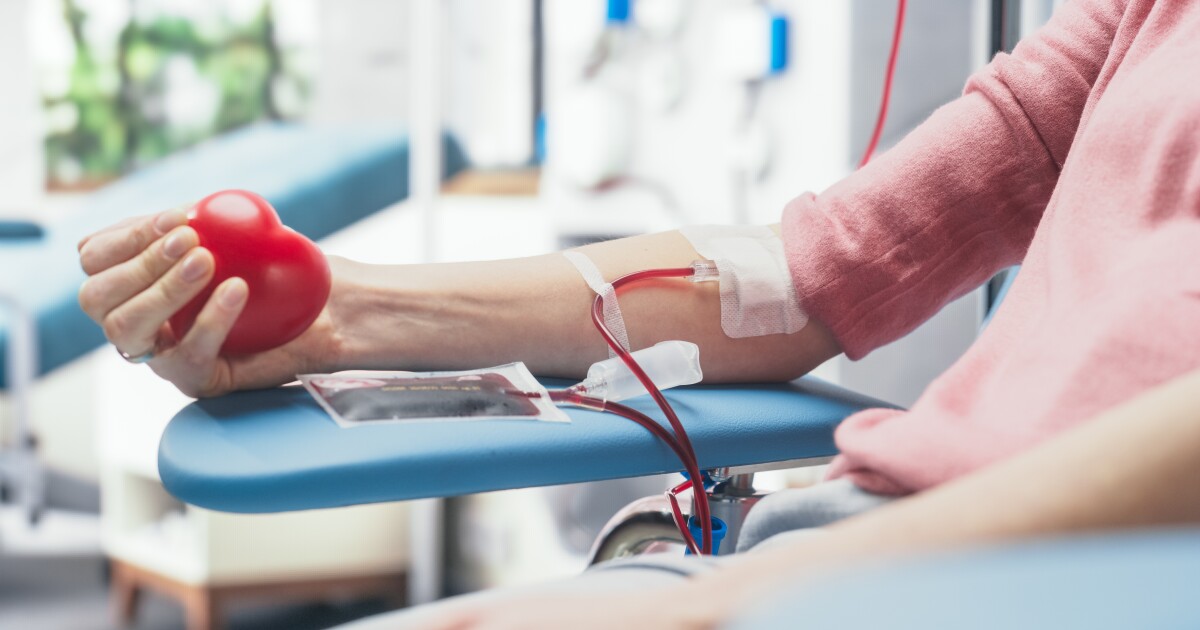Designed by a self-taught craftsman dubbed “God’s Architect,” a concrete castle built to weather any disaster has hit the market in Malibu for $35 million, offering both fortress-like protection and a retreat-style atmosphere above the…
Blog
-

Cillian Murphy meets Barry Keoghan in first look at Peaky Blinders film | Peaky Blinders
Two stars of Irish acting are united as Cillian Murphy meets Barry Keoghan in the first look at the eagerly anticipated Peaky Blinders film.
Murphy questions his identity as “famous gypsy gangster” Tommy Shelby in the 70-second teaser released…
Continue Reading
-

Journal of Medical Internet Research
Introduction
Sleep is a fundamental physiological process essential for maintaining physical health, mental well-being, and overall quality of life. However, it remains an underrecognized priority in public health agendas, particularly in low- and middle-income countries []. According to the 2025 China National Health Sleep White Paper, sleep quality among residents remains suboptimal, with approximately 64% experiencing sleep disturbances once or twice per week. []. The prevalence and severity of sleep disturbances vary across age groups. Young and middle-aged adults, as a core segment of the workforce, are particularly vulnerable to sleep disturbances due to occupational stress, long working hours, and irregular schedules [-]. Chronic sleep disturbance impairs stress management and exacerbates emotional distress while also being associated with poorer health outcomes, placing a burden on health care systems and reducing workplace productivity [,].
Sleep quality is influenced by multiple factors, including socioeconomic, physiological, psychological, and behavioral elements [,]. While these factors contribute to variations in sleep quality, increasing attention has been directed toward the role of eHealth literacy in health management. Defined as an individual’s ability to access, understand, evaluate, and apply health information from digital sources to make informed health decisions [], eHealth literacy has been shown to facilitate changes in health-related behaviors by bridging the gap between health information acquisition and actionable practices []. A systematic review further confirmed that eHealth literacy is associated with positive outcomes, including improved health behaviors, better psychological well-being, and increased use of health services []. These findings suggest that individuals with higher eHealth literacy are better equipped to adopt and maintain health-promoting behaviors that improve sleep outcomes.
While the significance of eHealth literacy in facilitating health-related behavior changes is recognized, its specific impact on sleep quality remains inadequately investigated. Some studies have suggested potential pathways through which eHealth literacy may influence sleep quality. For example, higher eHealth literacy has been associated with greater adherence to sleep hygiene practices [], potentially by enhancing individuals’ ability to identify and apply credible health information, thereby promoting better sleep quality. Another study indicated that higher eHealth literacy could reduce the risk of cyberchondria, which is subsequently associated with improved sleep quality []. However, evidence regarding the direct relationship between eHealth literacy and sleep quality is limited.
The association between eHealth literacy and sleep quality may vary by age. Previous research indicates that eHealth literacy is typically higher among younger populations [,]. Younger adults tend to engage more with digital health resources and may benefit significantly from them in managing sleep-related issues []. In contrast, middle-aged adults often face barriers in accessing and using such tools effectively despite a growing need for sleep management as sleep quality tends to decline with age [,]. This age-related disparity, coupled with unequal engagement with digital health resources, could contribute to widening gaps in sleep health—reflecting a digital health divide []. Therefore, understanding how eHealth literacy influences sleep quality across age groups is critical in addressing this divide.
This study aimed to examine the association between eHealth literacy and sleep quality across age groups among adults aged 18 to 59 years in Shanghai, China. By providing empirical evidence on age-specific associations, this study sought to inform tailored sleep interventions that incorporate eHealth literacy enhancement and address disparities arising from the digital health divide.
Methods
Participants and Procedure
This study was conducted between October and December 2022 in Shanghai. Three districts representing urban, periurban, and rural areas were randomly selected. Seven community health service centers from these districts that agreed to participate in the study were included. At each center, community residents were recruited using a convenience sampling approach. Before completing the survey, trained staff provided a detailed explanation of the study’s purpose and requirements, emphasizing the anonymity of responses. Participants were required to sign an informed consent form before proceeding with the questionnaire.
The inclusion criteria were (1) residence in Shanghai, (2) age 18 to 59 years, and (3) provision of informed consent and agreement to participate in the survey. The exclusion criteria were (1) severe hearing or speech impairments and (2) inability to comprehend the survey due to mental or cognitive conditions. Anonymous questionnaires were completed through the online survey platform Wenjuanxing.
The sample size was calculated using the prevalence of poor sleep quality as the primary outcome. On the basis of previous literature, the prevalence of poor sleep quality was estimated to be approximately 35%, with an allowable error of 3.5%. Using the PASS software for cross-sectional survey sample size calculation (NCSS, LLC), the minimum required sample size was determined to be 740. Considering the design effect of 2 due to convenience sampling and an anticipated nonresponse rate of 15%, the adjusted minimum required sample size was 1742.
A total of 1872 eligible participants were invited, and 1810 valid questionnaires were collected, yielding an effective response rate of 96.7%. The final sample size met the minimum requirement for analysis.
Measurements
eHealth Literacy
The Chinese version of the eHealth Literacy Scale (eHEALS), a translation of the original scale developed by Norman and Skinner [], was used to assess participants’ eHealth literacy []. This scale consists of 8 items, each rated on a 5-point Likert scale ranging from 1 (“strongly disagree”) to 5 (“strongly agree”), yielding a total score between 8 and 40. Higher average scores indicate better self-perceived skills, knowledge, and comfort regarding online health information. The eHEALS has good reliability and validity among Chinese adults [,]. In this study, the scale showed good internal consistency, with a Cronbach α of 0.98.
Sleep Quality
The Pittsburgh Sleep Quality Index (PSQI) was used to measure participants’ sleep quality over the previous month []. The scale consists of 19 items evaluating 7 components: subjective sleep quality, sleep latency, sleep duration, habitual sleep efficiency, sleep disturbances, use of sleep medication, and daytime dysfunction. The sum of the component scores yields a total score ranging from 0 to 21, with higher scores indicating poorer sleep quality. According to the recommended cutoff in the original study describing the PSQI, a total score of 5 or lower indicates good sleep quality, whereas a score above 5 indicates poor sleep quality []. The PSQI has demonstrated good psychometric robustness and factorial structure among Chinese adults [,].
Covariates
The selection of covariates was guided by the biopsychosocial theoretical framework [], which conceptualizes sleep quality as an outcome shaped by biological, psychological, and social determinants. Therefore, covariates were categorized into 3 domains as follows.
Biological Factors
Biological factors included sex (male or female), age, and weight status. Weight status was derived from self-reported height and weight, with BMI calculated as weight (kg) divided by height squared (m2). Overweight or obesity was defined based on the BMI classification criteria recommended by the Working Group on Obesity in China [].
Psychological Factors
Psychological factors included depressive and anxiety symptoms. Depressive symptoms were assessed using the Patient Health Questionnaire–9, with total scores ranging from 0 to 27. Scores of ≥5, 10, and 15 represent mild, moderate, and severe depressive symptoms, respectively []. In this study, the Patient Health Questionnaire–9 demonstrated good internal consistency (Cronbach α=0.964).
Anxiety symptoms were measured using the Generalized Anxiety Disorder–7 scale, with total scores ranging from 0 to 21. Scores of ≥5, 10, and 15 represent mild, moderate, and severe anxiety symptoms, respectively []. In this study, the Generalized Anxiety Disorder–7 exhibited good internal consistency (Cronbach α=0.978).
Social Factors
Social factors included educational attainment (junior high school or lower, senior high school, or college or higher), employment status (employed or unemployed), family monthly income (<¥5000 [US $707.30], ¥5001-¥9999 [US $707.44-$1414.45], ¥10,000-¥19,999 [US $1414.59-$2829.04], or ≥¥20,000 [US $2829.18]), marital status (either married or single, divorced, or widowed), and residential area (urban, periurban, or rural).
Statistical Analysis
Participants were first categorized into 3 age groups: emerging adults (18‐29 years) [], established adults (30‐45 years) [], and middle-aged adults (46‐59 years). Descriptive statistics were used to summarize their background variables, eHealth literacy, and sleep quality by age group. Given the skewed distribution of eHEALS scores, eHealth literacy was categorized into 3 groups based on IQRs: 25th percentile or below (lowest quartile), 25th to 75th percentile (middle quartiles), and 75th percentile or above (highest quartile). Differences in eHealth literacy and sleep quality among the 3 age groups were examined using chi-square tests.
To examine the association between eHealth literacy and sleep quality, multivariable logistic regression analyses were conducted in a stepwise manner. Model 1 adjusted for biological factors, including sex, age, and BMI. Model 2 incorporated additional adjustments for psychological factors, including depressive and anxiety symptoms. Model 3 further adjusted for social factors, including educational attainment, household monthly income, employment status, marital status, and residential area, to evaluate whether these factors influenced the association between eHealth literacy and sleep quality.
Finally, age-stratified analyses were performed to explore whether the association between eHealth literacy and sleep quality varied across age groups. In sensitivity analyses, we further included potential confounding variables, including chronic disease status and health behaviors (smoking and alcohol consumption), to assess the robustness of the findings.
Ethical Considerations
The study protocol was approved by the ethics committee of the Xuhui District Center for Disease Control and Prevention (XHLL202205). Written informed consent was obtained from all participants. Participant privacy and confidentiality were strictly protected. All data were anonymized and securely stored, with access limited to the research team.
Results
Descriptive Characteristics of the Sample
presents the sample characteristics. Of the 1810 participants, 673 (37.2%) were male, and 1137 (62.8%) were female, with a mean age of 40.0 (SD 10.1) years. Of these, 15.7% (285/1810) were emerging adults (18‐29 years), 53.3% (965/1810) were established adults (30-45 years), and 30.9% (560/1810) were middle-aged adults (45‐59 years). Most had a college degree or higher (n=1351, 74.6%), were employed (n=1533, 84.7%), and were married (n=1429, 79%). Approximately half (n=927, 51.2%) reported a monthly household income of ≥¥10,000 (US $1414.59). Regarding residence, 20.7% (375/1810) lived in urban areas, 30.4% (550/1810) lived in periurban areas, and 48.9% (885/1810) lived in rural areas. A total of 21.2% (384/1810) had moderate to severe depressive symptoms, and 15% (271/1810) had moderate to severe anxiety symptoms.
Table 1. Sample characteristics by age group (N=1810). Total, n (%) Emerging adults (n=285), n (%) Established adults (n=965), n (%) Middle-aged adults (n=560), n (%) Sex Male 673 (37.2) 132 (46.3) 345 (35.8) 196 (35.0) Female 1137 (62.8) 153 (53.7) 620 (64.2) 364 (65.0) Weight status Normal weight or underweight 1159 (64.0) 191 (67.0) 637 (66.0) 331 (59.1) Overweight 514 (28.4) 65 (22.8) 254 (26.3) 195 (34.8) Obesity 137 (7.6) 29 (10.2) 74 (7.7) 34 (6.1) Depressive symptoms None 776 (42.9) 113 (39.6) 399 (41.3) 264 (47.1) Mild 650 (35.9) 91 (31.9) 349 (36.2) 210 (37.5) Moderate 135 (7.5) 18 (6.3) 79 (8.2) 38 (6.8) Severe 249 (13.8) 63 (22.1) 138 (14.3) 48 (8.6) Anxiety symptoms None 971 (53.6) 133 (46.7) 500 (51.8) 338 (60.4) Mild 568 (31.4) 91 (31.9) 310 (32.1) 167 (29.8) Moderate 190 (10.5) 43 (15.1) 110 (11.4) 37 (6.6) Severe 81 (4.5) 18 (6.3) 45 (4.7) 18 (3.2) Educational attainment Junior high school or lower 176 (9.7) 11 (3.9) 39 (4.0) 126 (22.5) Senior high school 283 (15.6) 17 (6.0) 105 (10.9) 161 (28.8) College or higher 1351 (74.6) 257 (90.2) 821 (85.1) 273 (48.8) Employment status Employed 1533 (84.7) 248 (87.0) 924 (95.8) 361 (64.5) Unemployed 277 (15.3) 37 (13.0) 41 (4.2) 199 (35.5) Family monthly income <¥5000 (US $707.30) 349 (19.3) 53 (18.6) 152 (15.8) 144 (25.7) 5001-¥9999 (US $707.44-$1414.45) 534 (29.5) 96 (33.7) 285 (29.5) 153 (27.3) 10,000-¥19,999 (US $1414.59-$2829.04) 543 (30.0) 85 (29.8) 302 (31.3) 156 (27.9) ≥20,000 (US $2829.18) 384 (21.2) 51 (17.9) 226 (23.4) 107 (19.1) Marital status Married 1429 (79.0) 82 (28.8) 834 (86.4) 513 (91.6) Single, divorced, or widowed 381 (21.0) 203 (71.2) 131 (13.6) 47 (8.4) Residential area Urban 375 (20.7) 43 (15.1) 197 (20.4) 135 (24.1) Periurban 550 (30.4) 96 (33.7) 289 (29.9) 165 (29.5) Rural 885 (48.9) 146 (51.2) 479 (49.6) 260 (46.4) eHealth literacy score Below the 25th percentile 440 (24.3) 79 (27.7) 221 (22.9) 140 (25.0) Between the 25th and 75th percentiles 909 (50.2) 117 (41.1) 472 (48.9) 320 (57.1) Above the 75th percentile 461 (25.5) 89 (31.2) 272 (28.2) 100 (17.9) Sleep quality Good 1124 (62.1) 190 (66.7) 617 (63.9) 317 (56.6) Poor 686 (37.9) 95 (33.3) 348 (36.1) 243 (43.4) The median score on the eHEALS was 32 (IQR 28-40). The prevalence of poor sleep quality was 37.9% (686/1810). Chi-square analysis revealed significant associations between age group and both eHealth literacy (χ24=32.0; P<.001) and sleep quality (χ22=11.1; P=.004). Compared to younger adults, a lower proportion of middle-aged adults had eHealth literacy scores above the 75th percentile. Additionally, the proportion of middle-aged adults reporting poor sleep quality was higher than that of younger adults.
Association Between eHealth Literacy and Poor Sleep Quality: Multimodel Regression
The association between eHealth literacy and poor sleep quality was examined using multimodel logistic regression (). In model 1, after adjusting for biological factors, participants with eHealth literacy scores between the 25th and 75th percentiles (odds ratio [OR] 1.876, 95% CI 1.463-2.406, P<.001) and those with scores below the 25th percentile (OR 2.289, 95% CI 1.726-3.037, P<.001) had a significantly higher likelihood of reporting poor sleep quality compared to those with scores above the 75th percentile. After further adjusting for psychological factors in model 2, this association remained statistically significant (OR 1.574, 95% CI 1.204-2.058, P<.001 for scores between the 25th and 75th percentiles; OR 1.526, 95% CI 1.115-2.088, P=.008 for scores below the 25th percentile). The association persisted even after additional adjustment for social factors in model 3 (OR 1.594, 95% CI 1.216-2.089, P<.001 for scores between the 25th and 75th percentiles; OR 1.584, 95% CI 1.149-2.182, P=.005 for scores below the 25th percentile).
Table 2. Association between eHealth literacy and poor sleep quality using multivariable logistic regression (N=1810). Model 1 Model 2 Model 3 OR (95% CI) P value OR (95% CI) P value OR (95% CI) P value eHealth literacy Below the 25th percentile Reference — Reference — Reference — Between the 25th and 75th percentiles 1.876 (1.463-2.406) <.001 1.574 (1.204-2.058) <.001 1.594 (1.216-2.089) <.001 Above the 75th percentile 2.289 (1.726-3.037) <.001 1.526 (1.115-2.088) .008 1.584 (1.149-2.182) .005 Sex Male Reference — Reference — Reference — Female 1.050 (0.852-1.294) .65 1.089 (0.878-1.351) .44 1.068 (0.856-1.332) .56 Age 1.012 (1.002-1.022) .02 1.020 (1.010-1.031) <.001 1.030 (1.016-1.044) <.001 Weight status Normal weight or underweight Reference — Reference — Reference — Overweight 0.875 (0.698-1.097) .25 0.848 (0.671-1.071) .17 0.852 (0.673-1.079) .18 Obesity 0.998 (0.684-1.454) .99 1.061 (0.718-1.567) .77 1.099 (0.740-1.632) .64 Depressive symptoms None — — Reference — Reference — Mild — — 2.276 (1.699-3.050) <.001 2.297 (1.711-3.085) <.001 Moderate — — 3.499 (2.199-5.566) <.001 3.402 (2.132-5.429) <.001 Severe — — 2.082 (1.156-3.749) .02 2.092 (1.156-3.784) .02 Anxiety symptoms None — — Reference — Reference — Mild — — 1.236 (0.923-1.654) .16 1.243 (0.927-1.667) .15 Moderate — — 1.620 (0.912-2.876) .10 1.641 (0.920-2.924) .09 Severe — — 1.632 (0.795-3.348) .18 1.741 (0.844-3.594) .13 Educational attainment Junior high school or lower — — — — Reference — Senior high school — — — — 0.654 (0.432-0.990) .045 College or higher — — — — 1.104 (0.742-1.642) .63 Employment status Employed — — — — Reference — Unemployed — — — — 1.211 (0.892-1.645) .22 Family monthly income <¥5000 (US $707.30) — — — — Reference — 5001-¥9999 (US $707.44-$1414.45) — — — — 1.010 (0.741-1.375) .95 10,000-19,999 (US $1414.59-$2829.04) — — — — 1.004 (0.728-1.386) .98 ≥¥20,000 (US $2829.18) — — — — 1.132 (0.794-1.614) .49 Marital status Married — — — — Reference — Single, divorced, or widowed — — — — 1.423 (1.073-1.889) .01 Residential area Urban — — — — Reference — Periurban — — — — 0.824 (0.620-1.097) .19 Rural — — — — 0.871 (0.664-1.143) .32 aAdjusting for sex and age.
bAdjusting for sex, age, depressive symptoms, and anxiety symptoms.
cAdjusting for sex, age, depressive symptoms, anxiety symptoms, educational attainment, employment status, family monthly income, marital status, and residential area.
dOR: odds ratio.
eNot applicable.
In the fully adjusted model (model 3), several covariates were also associated with poor sleep quality. Specifically, age (OR 1.030, 95% CI 1.016-1.044), depressive symptoms (OR 2.297, 95% CI 1.711-3.085 for mild; OR 3.402, 95% CI 2.132-5.429 for moderate; OR 2.092, 95% CI 1.156-3.784 for severe), educational attainment (OR 0.654, 95% CI 0.432-0.990 for senior high school), and marital status (OR 1.423, 95% CI 1.073-1.889 for single, divorced, or widowed) were associated with poor sleep quality.
Age-Stratified Analysis of the Association Between eHealth Literacy and Poor Sleep Quality
presents the age-stratified analysis of the association between eHealth literacy and sleep quality across the 3 age groups. Among emerging adults, participants with eHealth literacy scores between the 25th and 75th percentiles (OR 2.491, 95% CI 1.133‐5.479, P=.02) and those with scores below the 25th percentile (OR 2.975, 95% CI 1.230‐7.195, P=.02) had significantly higher odds of reporting poor sleep quality compared with those with scores above the 75th percentile.
Table 3. Association between eHealth literacy and poor sleep quality using multivariable logistic regression stratified by age. Emerging adults (n=285) Established adults (n=965) Middle-aged adults (n=560) OR (95% CI) P value OR (95% CI) P value OR (95% CI) P value eHealth literacy Above the 75th percentile Reference — Reference — Reference — Between the 25th and 75th percentiles 2.491 (1.133-5.479) .02 1.439 (1.001-2.067) .049 1.651 (0.985-2.770) .06 Below the 25th percentile 2.975 (1.230-7.195) .02 1.303 (0.834-2.036) .24 1.639 (0.901-2.980) .11 Sex Male Reference — Reference — Reference — Female 0.565 (0.303-1.053) .07 1.150 (0.844-1.569) .38 1.198 (0.793-1.810) .39 Age 1.087 (0.970-1.218) .15 1.011 (0.979-1.045) .51 1.021 (0.968-1.080) .45 Weight status Normal weight or underweight Reference — Reference — Reference — Overweight 1.047 (0.500-2.193) .90 0.760 (0.541-1.069) .12 0.924 (0.629-1.360) .69 Obesity 1.354 (0.482-3.801) .57 1.040 (0.604-1.789) .89 1.186 (0.551-2.550) .66 Depressive symptoms None Reference — Reference — Reference — Mild 4.148 (1.501-11.467) .006 2.386 (1.570-3.627) <.001 1.933 (1.202-3.110) .007 Moderate 6.356 (1.573-25.685) .009 3.407 (1.796-6.463) <.001 3.102 (1.324-7.270) .009 Severe 4.389 (1.019-18.904) .047 1.594 (0.690-3.681) .28 2.773 (0.834-9.210) .10 Anxiety symptoms None Reference — Reference — Reference — Mild 1.361 (0.539-3.438) .51 1.219 (0.807-1.842) .35 1.263 (0.774-2.060) .35 Moderate 1.023 (0.235-4.447) .98 2.361 (1.058-5.271) .04 0.996 (0.323-3.070) .99 Severe 3.747 (0.674-20.832) .13 2.408 (0.874-6.637) .09 0.567 (0.122-2.630) .47 Educational attainment Junior high school or lower Reference — Reference — Reference — Senior high school 0.095 (0.007-1.282) .08 0.730 (0.307-1.736) .48 0.696 (0.420-1.150) .16 College or higher 1.277 (0.279-5.848) .75 1.580 (0.715-3.491) .26 0.801 (0.468-1.370) .42 Employment status Employed Reference — Reference — Reference — Unemployed 1.605 (0.600-4.294) .35 1.152 (0.578-2.299) .69 1.081 (0.679-1.720) .74 Family monthly income <¥5000 (US $707.30) Reference — Reference — Reference — 5001-¥9999 (US $707.44-$1414.45) 0.557 (0.240-1.289) .17 0.997 (0.627-1.584) .99 1.101 (0.660-1.840) .71 10,000-¥19,999 (US $1414.59-$2829.04) 0.530 (0.216-1.299) .17 0.904 (0.560-1.460) .68 1.296 (0.762-2.200) .34 ≥¥20,000 (US $2829.18) 0.729 (0.266-1.998) .54 1.100 (0.657-1.841) .72 1.336 (0.729-2.450) .35 Marital status Married Reference — Reference — Reference — Single, divorced, or widowed 0.964 (0.469-1.978) .92 1.736 (1.150-2.621) .009 1.354 (0.711-2.580) .36 Residential area Urban Reference — Reference — Reference — Periurban 0.682 (0.294-1.584) .37 0.816 (0.546-1.219) .32 0.856 (0.527-1.390) .53 Rural 0.547 (0.242-1.235) .15 0.868 (0.588-1.281) .48 0.897 (0.564-1.430) .65 aOR: odds ratio.
bNot applicable.
Among established adults, participants with scores below the 25th percentile showed no statistically significant association (OR 1.303, 95% CI 0.834‐2.036, P=.24), whereas the group between the 25th and 75th percentiles showed a positive association (OR 1.439, 95% CI 1.001‐2.067, P=.049). However, this association was not statistically significant among middle-aged adults (OR 1.651, 95% CI 0.985‐2.770, P=.06 for scores between the 25th and 75th percentiles; OR 1.639, 95% CI 0.901‐2.980, P=.11 for scores below the 25th percentile).
Sensitivity Analysis
Sensitivity analyses adjusting additionally for smoking, alcohol consumption, and chronic disease status are presented in . Among emerging adults, lower eHealth literacy remained significantly associated with higher odds of poor sleep quality (OR 2.330, 95% CI 1.045‐5.197, P=.04 for scores between the 25th and 75th percentiles; OR 2.564, 95% CI 1.017‐6.464, P=.046 for scores below the 25th percentile). Among established adults, lower eHealth literacy did not show a statistically significant association after additional adjustment (OR 1.377, 95% CI 0.953‐1.991, P=.09 for scores between the 25th and 75th percentiles; OR 0.776, 95% CI 0.776‐1.930, P=.39 for scores below the 25th percentile). Among middle-aged adults, results also remained nonsignificant (OR 1.539, 95% CI 0.910‐2.600, P=.11 for scores between the 25th and 75th percentiles; OR 1.476, 95% CI 0.802‐2.710, P=.21 for scores below the 25th percentile).
Discussion
Principal Findings
This study investigated the association between eHealth literacy and sleep quality among adults aged 18 to 59 years in Shanghai, China. Overall, lower eHealth literacy scores were associated with a higher likelihood of poor sleep quality even after adjusting for biological, psychological, and social factors. The stratified analysis revealed that this association was significant among younger adults but not among middle-aged adults. These findings provide empirical evidence supporting the role of eHealth literacy as a potential determinant of sleep quality, particularly among younger populations.
The significant association observed in this study is consistent with prior research linking limited health literacy to poorer sleep outcomes and increased sleep disturbances [,]. While existing studies have largely focused on traditional health literacy, emerging research suggests that eHealth literacy may play a comparable role in health management in digital contexts []. Extending previous findings that link eHealth literacy to better adherence to sleep hygiene practices [], our results suggest a more direct association between eHealth literacy and overall sleep quality. Individuals with higher eHealth literacy are better equipped to critically evaluate online health information and adopt evidence-based sleep practices. In contrast, limited eHealth literacy may increase vulnerability to online misinformation and suboptimal sleep practices, ultimately leading to poorer sleep outcomes.
Beyond eHealth literacy, several other factors, including age, educational level, marital status, and depressive symptoms, were also associated with sleep quality in the overall model, consistent with findings from previous research [,]. Among these factors, depressive symptoms emerged as a well-established and particularly strong predictor of sleep disturbances []. Individuals with mild to severe depressive symptoms had approximately 2 to 3 times higher odds of reporting poor sleep quality compared with those without depressive symptoms. This strong psychological effect may have attenuated the independent contributions of other covariates when adjusting simultaneously. In addition, prior studies have shown that individuals with lower eHealth literacy tend to experience greater psychological distress [], partly due to the misuse of misleading or low-quality information encountered online. These patterns suggest that mental health may play an important role in the pathway through which eHealth literacy relates to sleep quality.
In the age-stratified analysis, lower eHealth literacy was associated with poorer sleep quality only among emerging and established adults. This finding aligns with those of prior research indicating that younger adults typically engage more actively with digital health information [,] and rely more on online resources for health-related decisions. In contrast, middle-aged and older adults tend to depend more on traditional health care resources [], making their sleep quality less influenced by online health information use. Furthermore, this age-specific association may also reflect distinct underlying mechanisms of sleep disturbances. Among middle-aged adults, sleep disturbance is more frequently attributed to age-related neurophysiological and neurochemical changes (eg, reduced sleep duration and increased fragmentation) []. Such physiologically driven sleep disturbances are only minimally related to eHealth literacy. Conversely, younger adults often experience irregular sleep patterns driven by external demands (eg, academic or occupational stress) [,], which may be more amenable to modification through improved eHealth literacy.
The age-specific association between eHealth literacy and sleep quality aligns with broader concerns about the digital health divide []. Although digital health technologies offer scalable and cost-effective solutions for health management, their benefits are not equitably distributed across age groups. Structural barriers such as limited access, lower digital confidence, and affordability disproportionately affect marginalized and older populations []. As sleep disturbances tend to increase with age, middle-aged adults may face a dual challenge: increased physiological susceptibility to poor sleep and reduced capacity to engage with digital resources. However, existing eHealth interventions aimed at improving sleep outcomes have predominantly targeted younger populations [-]. Without targeted support, the expansion of digital health tools may unintentionally widen existing age-related disparities in sleep health.
Our findings highlight the importance of improving eHealth literacy to promote better sleep outcomes. For example, a 6-week online intervention during the COVID-19 pandemic integrated health education and digital skill training to improve university students’ eHealth literacy and related health behaviors []. Although short-term sleep improvements were limited, the study highlighted the potential of eHealth literacy–based interventions and the importance of long-term evaluation []. Given the age-stratified association observed in our study, tailoring interventions to address age-specific barriers is essential. Middle-aged adults, who have lower digital engagement, may require additional support to effectively benefit from digital tools—such as affordable internet access, community-based digital skill training, and user-friendly interface design []. By accounting for the unique needs of different age groups, eHealth literacy can be leveraged to improve health outcomes for all, ultimately advancing digital health equity.
Strengths and Limitations
This study has several strengths, including adjustment for multiple confounders at different levels and an age-stratified analysis, offering a more nuanced understanding of the association between eHealth literacy and sleep quality. However, several limitations should be acknowledged. First, the cross-sectional design precludes causal inferences between eHealth literacy and sleep quality. Future studies should use longitudinal or experimental designs to clarify temporal relationships and causal pathways between eHealth literacy and sleep outcomes. Second, the study was conducted exclusively among adults in Shanghai, limiting generalizability to other regions with different levels of health literacy. Third, reliance on self-reported measures for eHealth literacy and sleep quality may introduce recall and social desirability biases, potentially affecting the accuracy of the results. Fourth, due to the need to minimize respondent burden, alcohol use and smoking were assessed using frequency-based measures rather than consumption volume. This may not fully capture the potentially nonlinear associations between these behaviors and sleep quality. Fifth, the overall sample size was relatively limited, particularly within certain age groups, which may have affected the statistical precision of the findings. Finally, we did not include key determinants of sleep such as work or study pressure, exercise habits, and online behaviors, which may introduce residual confounding. Future studies should incorporate these psychosocial and behavioral factors to more fully disentangle the association between eHealth literacy and sleep quality.
Conclusions
This study examined the association between eHealth literacy and sleep quality among adults aged 18 to 59 years in Shanghai, China. Findings showed that lower eHealth literacy was significantly associated with a higher likelihood of reporting poor sleep quality. Age-stratified analysis further revealed that this relationship was significant among younger adults but not among middle-aged adults. These findings underscore the potential of enhancing eHealth literacy as an effective strategy for improving sleep health, particularly when tailored to age-specific needs and digital access levels. Targeted measures to reduce the digital health divide will be essential in promoting more equitable health outcomes across age groups.
This study was funded by the key discipline projects of the Shanghai Three-Year Action Plan for Public Health (grant GWVI-11.1-29).
The datasets generated or analyzed during this study are not publicly available due to privacy protections or ethical restrictions but are available from the corresponding author on reasonable request.
All authors have read and agreed to the published version of the manuscript.
None declared.
Edited by Amy Schwartz, Matthew Balcarras; submitted 11.Apr.2025; peer-reviewed by Li Li, Vivian Yawei Guo; final revised version received 26.Nov.2025; accepted 26.Nov.2025; published 24.Dec.2025.
© Yujie Liu, Wenjie Xue, Yuhui Sheng, Suping Wang, Ruijie Gong, Shangbin Liu, Chen Xu, Yong Cai. Originally published in the Journal of Medical Internet Research (https://www.jmir.org), 24.Dec.2025.
This is an open-access article distributed under the terms of the Creative Commons Attribution License (https://creativecommons.org/licenses/by/4.0/), which permits unrestricted use, distribution, and reproduction in any medium, provided the original work, first published in the Journal of Medical Internet Research (ISSN 1438-8871), is properly cited. The complete bibliographic information, a link to the original publication on https://www.jmir.org/, as well as this copyright and license information must be included.
Continue Reading
-

Whitehorse not at imminent risk of blackouts, says ATCO Electric Yukon
Listen to this article
Estimated 3 minutes
The audio version of this article is generated by AI-based technology. Mispronunciations can occur. We are working with our partners to continually review and improve the results.
The Yukon’s energy provider says Whitehorse is not at imminent risk of blackouts, but with very cold weather forecasted through the holidays, residents are still being asked to conserve power.
“We know people need to eat their Christmas dinner, that’s not going to be deferred,” said ATCO Electric vice-president Jay Massie. “But the dishwasher, the laundry, electrical heat, if you have baseboards in multiple rooms, some can be turned down while you’re cooking.”
On Wednesday, temperatures sank below -40 C in most Yukon communities, including Whitehorse, and fell to -50 C in Ross River and Faro, according to Environment Canada. The cold temperatures started on Dec. 9 — the result of a cold front from Siberia — and plunged most of the territory into a much colder-than-average December.
The Yukon’s energy minister warned on Tuesday that the territory’s energy grid was experiencing peak demand, and that Whitehorse could be subject to rolling blackouts as a last resort if maximum capacity is exceeded.
Rolling blackouts are a measure to mitigate widespread power outages when demand exceeds supply. Specific neighbourhoods would temporarily lose power to give the whole system a break.
ATCO Electric is the territory’s power distributor and Yukon Energy is the energy utility.
Stephanie Cunha with Yukon Energy said on Wednesday that Yukoners are using 80 to 90 per cent of the territory’s available energy supply.
She said industrial customers and mine remediation sites have already been asked to disconnect from the grid and switch to diesel generators. Communities have also been switched over to diesel.

A thick ice fog shrouds the S.S. Klondike in downtown Whitehorse on Wednesday. (Virginie An/CBC) But Massie with ATCO Electric said the territory has a “good buffer” before it needs to move to rolling blackouts as a last resort.
“We’re in a fairly decent spot,” he said. “But it’s good to have this conversation [about rolling blackouts] so that people understand what they’re about.”
Yukon Energy has a multi-step emergency plan for managing peak demand, according to the utility’s website. There are multiple steps to alleviate pressure on the grid before rolling blackouts are necessary, including potentially sending an emergency alert to Yukoners asking them to immediately stop “all non-essential electricity use.”
In the meantime, Massie said, every little bit helps when it comes to saving energy.
Residents can conserve energy by using large appliances, like dishwashers and washing machines, outside of peak hours; turning off unused lights; unplugging unused electronics, like laptops; and using smaller appliances, like microwaves and toaster ovens, for cooking. Peak hours are between 7 a.m. and 10 a.m., and between 4 p.m. and 8 p.m.
Continue Reading
-

Ludicrous Lemon-Shaped World Is Like Nothing We’ve Ever Seen : ScienceAlert
A newly discovered exoplanet has to take the crown for the weirdest world we’ve ever spotted out there in the Milky Way galaxy.
It’s called PSR J2322-2650b, and everything about it is absolutely loony. It’s a hot Jupiter orbiting a…
Continue Reading
-

Why Gen Z says ‘hotties need hobbies’
This rebroadcast originally aired October 13, 2025.
Sewing, scrapbooking, sports clubs. Many Gen Z’ers are taking up real-world hobbies as an antidote to doomscrolling. Why hobbies make us happy — and how to get one.
Guests
Lexi Bynum, content…
Continue Reading
-

Seahawks Reveal Uniform Combination For Week 17 Matchup vs. Panthers
The Seahawks get set to hit the road for the penultimate game of the 2025 regular season as they will face off against the 8-7 Carolina Panthers at Bank of America Stadium. The team will wear their white jerseys and college navy pants in…
Continue Reading
-

Sidero Labs Extends Talos Linux Directly to Broadcom VMs
ATLANTA — Sidero Labs’ Talos Linux was created to offer an alternative to the high cost and complexity of managing disparate Kubernetes and other deployments. It serves as a lightweight but highly scalable operating system designed…
Continue Reading
-

Shawn Bell Promoted to Assistant Head Coach
HOUSTON – University of Houston Football Head Coach Willie Fritz announced the promotion of Shawn Bell to Assistant Head Coach and Quarterbacks Coach on Wednesday following two seasons as Quarterbacks Coach.
Houston’s passing game…Continue Reading
-

Northeast Ohio may see blood supply shortfall over the holidays
Northeast Ohio is facing a potential shortfall in blood donations this holiday season.
The American Red Cross is holding blood drives across the region in anticipation of winter weather that could cancel future blood drives.
Each day, the region’s 70 hospitals require about 500 pints of blood, Ryan Lang, of the American Red Cross’ Northern Ohio Region, said — and having an adequate supply can save lives.
“We could have people that need dozens of units of blood at one time,” Lang said. “We had a Northeast Ohio woman who went in to give birth, there were complications and she required 56 units of blood.”
Places like Holmes County with large Amish populations may be at particular risk of shortages, he said.
“They experience more trauma with accidents in those areas involving farm equipment and on the roads,” Lang said. “A lot of it has to do with mothers birthing at home and complications with childbirth.”
Lang said universal donors — those with Type O blood — are especially welcome.
This past January, the Red Cross announced it had to cancel hundreds of blood drives across the U.S. due to weather and wildfires in California.
Blood shortages can mean patients receive delayed treatment for conditions such as severe anemia, according to the Red Cross.
“It can be tempting to wonder if we truly need blood transfusions as much as we did in the past, or to question whether there may be alternatives to blood transfusion that could be pursued,” Dr. Eric Gehrie, executive medical director for the American Red Cross, wrote in 2024. “Yet the only feasible source of blood for transfusion is the arm of a generous blood donor.”
People can schedule donations at locations in Cleveland, Akron and Parma, or search for local drives online.
Continue Reading
